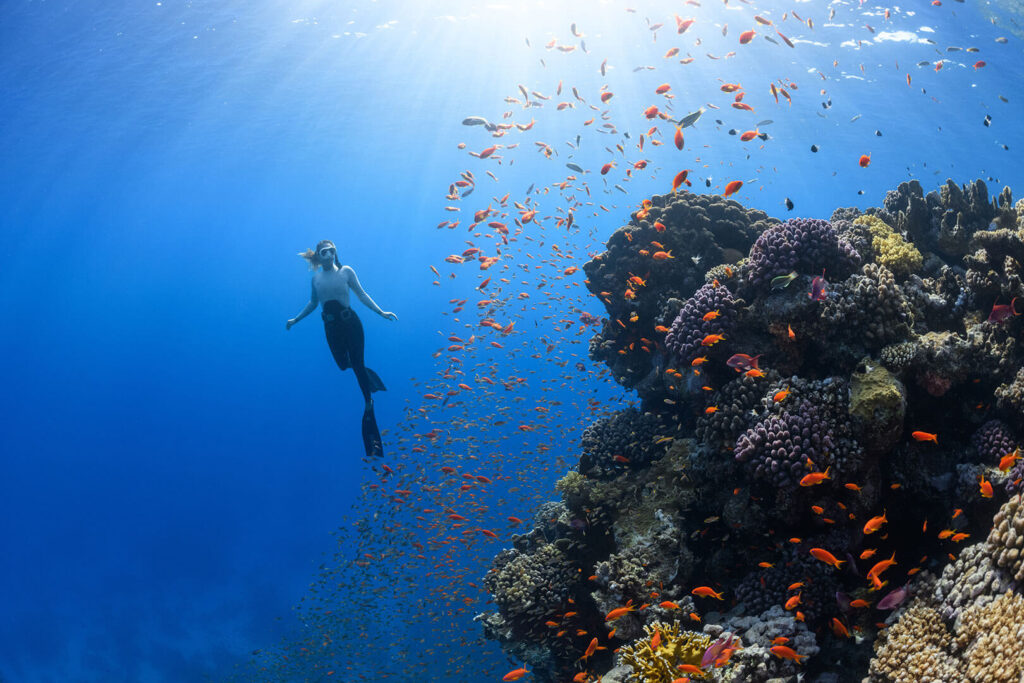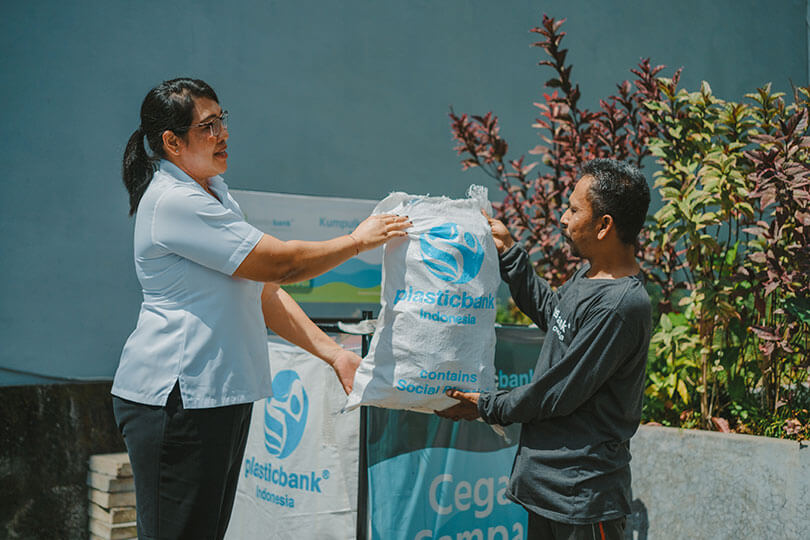Minutes to read: 6 minutes
 Photo by NEOM on Unsplash
Photo by NEOM on Unsplash
Picture yourself standing bare feet on a shore, where the land meets the vast expanse of shimmering blue. As you stare at the horizon, feel the ebb and flow of the vast ocean that connects us to all the remarkable life that thrives within and on it.
Covering 71 percent of our planet1, the ocean is a majestic force that sustains life in ways we are just beginning to comprehend. From the tiniest plankton to the largest whales, from vibrant coral reefs teeming with fish to the enigmatic creatures of the deep, the ocean cradles a rich tapestry of life that extends far beyond its shores.
It is a vital source of oxygen that fills us with a sense of freedom, a provider of sustenance that fills us with a sense of satiation, and a guardian against the ravages of climate change that fills us with a sense of protection. In the grand symphony of life, the ocean’s rhythm beats in unison with every living being. By the ocean, we are connected as one.
Understanding the ocean’s role
The ocean serves as a vital component of the Earth’s systems, impacting various aspects of our planet and its inhabitants. Let us dive deeper into the interconnectedness we share with the ocean and discover the myriad ways in which it shapes our existence.
Climate regulation
The ocean plays a crucial role in regulating global climate patterns due to its immense volume and heat-absorbing capacity. It stores vast amounts of solar energy, distributing it through ocean currents like the Gulf Stream, which influence weather patterns and moderate temperatures2. Changes in ocean temperatures and currents can lead to shifts in rainfall, sea-level rise, and extreme weather events, impacting global ecosystems, agriculture, animal and human populations.
Weather and atmospheric interactions
The ocean influences the weather and atmospheric processes. Evaporation from the ocean’s surface contributes to cloud formation and precipitation. The release of heat and moisture into the atmosphere fuels weather systems and affects patterns across continents. Understanding these interactions is vital for meteorology, climate modeling, and predicting and managing weather occurrences.
Oxygen production and carbon cycling
Marine plants, especially phytoplankton, play a critical role in oxygen production and carbon cycling. Through photosynthesis, they generate approximately 50 percent of the world’s oxygen3, while absorbing carbon dioxide, thus regulating the Earth’s atmospheric composition and mitigating climate change4. When phytoplanktons reach the end of their life cycle, the carbon dioxide they have absorbed is distributed throughout the ocean, even reaching the deep sea. This process transfers an estimated 10 gigatonnes of carbon dioxide from the atmosphere to the deep ocean4.
Biodiversity and food security
As a hotspot of biodiversity that supports an array of species and ecosystems, the ocean provides habitats for marine organisms, including fish, shellfish, and coral reefs, which are essential for food security, livelihood, and cultural practices of billions of people. The interconnectedness of ocean ecosystems — the coral reefs, mangroves, and seagrass beds — also support the productivity and health of adjacent coastal and terrestrial ecosystems.
Economic and trade connections
The ocean serves as a major conduit for global trade and economic activities. Shipping routes, supported by the ocean’s vast network of waterways, enable the transportation of goods, resources, and energy supplies between nations. The sea also supports various industries, including fishing, tourism, renewable energy generation (such as offshore wind farms), and the extraction of natural resources, contributing significantly to global economies.
 Plastic Bank collection members in Brazil collecting plastic by the ocean.
Plastic Bank collection members in Brazil collecting plastic by the ocean.
Stewarding the ocean
The interconnectedness we share with the ocean extends beyond the physical and biological aspects. It evokes a sense of wonder, inspiration, and stewardship. By recognizing our place within the intricate web of life, we gain a deeper understanding of the profound influence the ocean holds over our planet’s well-being.
As we commemorate this year’s World Oceans Day, we urge you to reflect on the urgent crisis of plastic pollution that threatens the interconnected web of life, like a plague. Alarming discoveries of giant plastic waste patches swirling in oceanic gyres, pervasive microplastics infiltrating even the most remote areas of the sea, and the devastating impact on marine life and human health emphasize the gravity of the situation.
Here are some quick facts about ocean plastic:
- About 11 billion kilograms of plastic waste enters the ocean every year and this can grow by 3x over the next 20 years5.
- Around 75 to 199 billion kilograms of plastic waste is estimated to be swimming in our ocean6.
- Ocean plastic kills 1 million seabirds and 100,000 marine animals annually due to plastic waste ingestion and entanglement7.
- Approximately 80 percent of all debris found in the ocean is plastic8.
- Blue whales are estimated to eat more than 10 million pieces of microplastic per day while humpback whales ingest as much as 200,000 pieces per day9.
- It is estimated that humans are ingesting over 53,000 microplastic annually by consuming seafood10.
We are not bystanders in the fight against ocean plastic pollution; our actions have far-reaching consequences. What we do as individuals travels through the ebbs and flows of life, affecting all beings connected through the ocean. Our choices, from consumption habits to waste disposal practices, directly impact the fate of our beloved ocean and its inhabitants.
 Plastic Bank collection member collecting plastic waste from a school in Indonesia.
Plastic Bank collection member collecting plastic waste from a school in Indonesia.
Stopping ocean plastic
You can be part of the solution and prevent plastic from flowing into the ocean! We invite you to join the Social Recycling movement at Plastic Bank. We are a social enterprise that reveals value in plastic waste by turning it into a currency that our collection community members can exchange for income and life-improving benefits. The collected plastic is sorted, recycled, and transformed into Social Plastic® feedstock for reuse in products and packaging – giving a second life to old plastic! By doing this, we’re not only stopping ocean plastic but also helping communities in vulnerable coastal areas find a path out of poverty.
Here are some of the ways you can get involved:
Spread the word: Share information about the Social Recycling movement with your friends, family, and social networks to inspire action and preserve our ocean.
Reduce your plastic footprint: Check out our Plastic Footprint Calculator and make conscious choices to minimize it. Choose reusable alternatives, bring your own bags and water bottles, and say no to unnecessary plastic packaging.
Make a contribution: Start your path of stewardship and help stop ocean plastic by making one-time or monthly contributions. Your support helps gather and grow collection communities across the vulnerable coastlines in Southeast Asia, Latin America, and Africa, while improving their lives with social and economic benefits.
Engage in corporate partnerships: If you own a business, explore our various Partnership Programs to discover how you can protect the ocean and support recycling, becoming a force for good.
Now is the time to act, as the ocean’s call resonates within us all. Together, let us forge a path of stewardship and preservation, honoring the interconnectedness that binds us to the sea.
Want to find out more about the Social Recycling movement? Get in touch with us at plasticbank.com/contact/!
- National Geographic Society, “Ocean,” National Geographic, Last updated July 16, 2022, https://education.nationalgeographic.org/resource/ocean/
- “How does the ocean affect climate and weather on land?” NOAA Ocean Exploration, https://oceanexplorer.noaa.gov/facts/climate.html
- Denis Loctier, “Every second breath you take comes from the ocean, says expert,” Euro News, Last updated February 23, 2022, https://www.euronews.com/green/2022/02/22/every-second-breath-you-take-comes-from-the-ocean
- “What are Phytoplankton?” NASA Earth Observatory, https://earthobservatory.nasa.gov/features/Phytoplankton
- “From Pollution to Solution,” UNEP, https://www.unep.org/interactives/pollution-to-solution/
- “Our planet is choking on plastic,” UNEP, https://www.unep.org/interactives/beat-plastic-pollution/
- “On World Oceans Day, UNESCO reinforces the importance of preserving the largest ecosystem on the planet,” UNESCO, June 8, 2020, Last updated April 20, 2023, https://www.unesco.org/en/articles/world-oceans-day-unesco-reinforces-importance-preserving-largest-ecosystem-planet
- “Marine plastic pollution,” IUCN, November 2021, https://www.iucn.org/resources/issues-brief/marine-plastic-pollution
- Josie Garthwaite, “How much microplastic do whales eat? Up to 10 million pieces per day, Stanford research finds,” Stanford News, November 1, 2022, https://news.stanford.edu/2022/11/01/whales-eat-colossal-amounts-microplastics/
- Wendee Nicole, “Microplastics in Seafood: How Much Are People Eating?” Environmental Health Perspectives, March 17, 2021, https://ehp.niehs.nih.gov/doi/full/10.1289/EHP8936